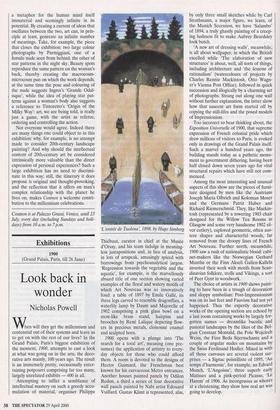Exhibitions
1900
(Grand Palais, Paris, till 26 June)
Look back in wonder
Nicholas Powell
hen will they get the millennium and centennial out of their systems and leave us to get on with the rest of our lives? In the Grand Palais, Paris's biggest exhibition of the moment, 1900, attempts to cast a look at what was going on in the arts, the deco- rative arts mainly, 100 years ago. The result is an immensely pretty, occasionally enter- taining potpourri comprising far too many, largely unrelated exhibits — 400 in all.
Attempting to inflict a semblance of intellectual mastery on such a greedy accu- mulation of material, organiser Philippe E'entree de Tuolend, 1898, by Hugo Simbeig Thiebaut, curator in chief at the Musee d'Orsay, and his team indulge in meaning- less juxtapositions and, in lieu of analysis, in lots of artspeak, amusingly spiced with borrowings from psychoanalytical jargon. 'Regression towards the vegetable and the aquatic', for example, is the marvellously absurd title of one section showing varied examples of the floral and watery motifs of which Art Nouveau was so innovatively fond: a table of 1897 by Emile Gale, its three legs carved to resemble dragonflies, a waterlily lamp by Daum and Majorelle of 1902 comprising a pink glass bowl on a stem-like brass stand, hairpins and brooches by Rene Lalique depicting flow- ers in precious metals, cloisonné enamel and sculpted horn.
1900 opens with a plunge into 'The search for a total art', meaning (one pre- sumes) the application of artistry to every- day objects for those who could afford them. A room is devoted to the designs of Hector Guimard, the Frenchman best known for his curvaceous Metro entrances. Another houses painted panels by Odilon Redon, a third a series of four decorative wall panels painted by Nabi artist Edouard Vuillard. Gustav Klimt is represented, alas, by only three small sketches while by Carl Strathmann, a major figure, we learn, of the Munich Secession, we have `Salambo' of 1894, a truly ghastly painting of a creep- ing lushness fit to make Aubrey Beardsley look butch.
'A new art of dressing walls', meanwhile, is all about wallpaper, in which the British excelled while 'The elaboration of new structures' is about, well, all sorts of things, including architecture and 'the lessons of rationalism' (watercolours of projects by Charles Rennie Mackintosh, Otto Wagn- er's Vienna Post Office), followed in quick succession and illogically by a charming set of photographs. Strung out along one wall without further explanation, the latter show how that nascent art form started off by copying the still-lifes and the posed models of Impressionism.
Too incorrect to bear thinking about, the Exposition Universelle of 1900, that supreme expression of French colonial pride which drew millions of visitors to Paris, is evoked only in drawings of the Grand Palais itself. Such a marvel a hundred years ago, the building stands today as a pathetic monu- ment to government dithering, having been half closed down seven years ago for vital structural repairs which have still not com- menced.
Among the most interesting and unusual aspects of this show are the pieces of furni- ture designed by men like the Austrians Joseph Maria Olbrich and Koloman Moser and the Germans Patriz Huber and Richard Riemerschmid. They, like Mackin- tosh (represented by a towering 1903 chair designed for the Willow Tea Rooms in Glasgow and some very handsome 1902 sil- ver cutlery), explored geometric, often aus- tere shapes and characterful woods, far removed from the droopy lines of French Art Nouveau. Further north, meanwhile, 1900 saw a rush of nationalistic blood: cabi- net-makers like the Norwegian Gerhard Munthe or the Finn Akseli Gallen-Kallela invested their work with motifs from Scan- dinavian folklore, trolls and Vikings, a sort of Peer Gynt in woodwork.
The choice of artists in 1900 shows paint- ing to have been in a trough of decoration and sloppy symbolism: Post-Impressionism was on its last feet and Fauvism had not yet happened. Thus the expertly decorative works of the opening section are echoed by a last room containing works by largely for- gotten names — dreamlike bucolic and pastoral landscapes by the likes of the Bel- gian Constant Montald, the Pole Wojciech Weiss, the Finn Beda Stjernschantz and a couple of angular nudes on mountains by the Swiss Ferdinand Hodler. Mixed in with all those canvases are several violent sur- prises — a Signac pointilliste of 1895, 'Au temps d'harmonie', for example, an Edvard Munch, `L'Angoisse', three superb early Matisses and a pink-period Picasso, 'Le Harem' of 1906. As incongruous as whores at a christening, they show how real art was going to develop.


























































 Previous page
Previous page